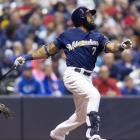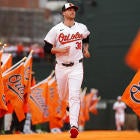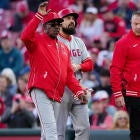On this Friday morning, roughly three weeks into the 2017 regular season, Brewers first baseman Eric Thames leads all of baseball in home runs (eight), slugging percentage (.981), OPS (1.481) and the FanGraphs version of WAR (1.6). He's second in both batting average (.415) and on-base percentage (.500). In the super early going, Thames has been a one-man army for Milwaukee.
The 30-year-old Thames clocked his eighth home run of the season Thursday -- it was his seventh home run in his past eight games -- to help the Brewers beat the NL Central rival Cardinals (MIL 7, STL 5). Here is video of his latest blast:
As I'm sure you know, Thames returned to MLB this season after spending the past three years in Korea. He was a good prospect back in the day with the Blue Jays, not a great one, and he struggled in the big leagues from 2011-12 before finding himself overseas. In three years with the NC Dinos of the Korea Baseball Organization, Thames hit .349/.451/.721 with 124 home runs in 390 games. He was named KBO MVP in 2015 after hitting 47 homers in 142 games.
Thames has always had power. He smacked 27 home runs in 130 Double-A games in 2010, and from 2011-13, he hit 23 homers in 238 minor-league games around big league call-ups. Baseball America ranked Thames as the 12th-best prospect in Toronto's farm system before the 2011 season. Here's part of their scouting report from their 2011 Prospect Handbook:
Thames headed into last offseason knowing he needed to find a way to stay healthy. He dialed back on weightlifting and started doing yoga to add flexibility. His efforts came to fruition in 2010, as he played in 130 games, led Toronto farmhands with 104 RBIs and showed the best lefthanded power in the system. Thames has excellent bat speed and plus power. He can get too aggressive, chase pitches and pile up strikeouts, but he also draws his share of walks.
The power has always been there. What Thames struggled with during his first stint in the big leagues was plate discipline, and this goes beyond simple strikeout and walk rates. (Thames had a 25.6 percent strikeout rate and a 5.6 percent walk rate from 2011-12. This year those numbers are 19.4 percent and 12.9 percent.) The goal of plate discipline is making sure you swing at good pitches.
Let's compare 2011-12 Thames to 2017 Thames in two key plate discipline stats: swing rate on pitches out of the zone (chase rate) and contact rate on pitches in the zone. You don't want to chase pitches out of the strike zone, obviously. And when you do swing at pitches in the strike zone, you want to make contact. Swinging through pitches in the zone is bad news. Here are the numbers:
Plate Appearances | Contact Rate in Zone | Chase Rate | |
2011-12 Thames | 684 | 85.3% | 34.2% |
2017 Thames | 62 | 91.8% | 15.9% |
2017 MLB Average | 85.5% | 30.2% | |
It's still April, so every stat you see at this point comes with a small sample size warning, and that is definitely true here. I will note swing and contact rates are among the quickest stats to stabilize, however. Swing rate is pretty stable after only 50 plate appearances. For contact rate, you have to wait for 100 plate appearances. Thames is already over the threshold for swing rate and is closing in on the threshold for contact rate.
Anyway, the point is Thames is not swinging at pitches out of the strike zone. Pitchers can't get him to chase. There are 191 players with enough plate appearances to qualify for the batting title and Thames has the third-lowest chase rate among those players. Only Twins outfielder Robbie Grossman (13.9 percent) and Dodgers second baseman Logan Forsythe (15 percent) have swung at a lower percentage of pitches out of the zone.
Earlier in his career Thames chased off the plate regularly, which created an obvious problem. Pitchers did not have to challenge him. Now Thames won't chase out of the zone, allowing him to see more hitter's counts and thus have more opportunities to do damage. The result:
Eric Thames is taking advantage of mistake pitches... 4 of his HRs have been on pitches down the middle of the plate pic.twitter.com/5vMUnbjkcL
— Daren Willman (@darenw) April 21, 2017
Thames is getting himself into good hitter's counts, forcing the pitcher to come right after him, and he's punishing anything he sees over the plate. He still has to hit the ball, of course. Seeing more pitches in the zone doesn't guarantee success. But Thames' contact rate on pitches in the zone shows he is not swinging and missing as often as he did a few years back, and with his natural power, yes that will lead to some big numbers.
Can Thames maintain his new ultra-disciplined approach all season? That's the million-dollar question, and it will determine whether he continues to produce like an MVP candidate, or whether this goes into the books as nothing more than an April hot streak. He has always had power. But now if Thames has truly paired it with Joey Votto-level plate discipline, he will continue to be one of the most feared sluggers in baseball.






















